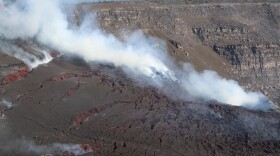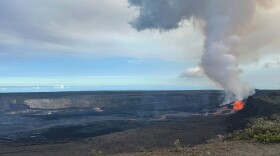-
Kīlauea erupted for six hours on Wednesday. Officials say lava fountains reached 1,300 feet, or 400 meters, before petering out. That is taller than New York's Empire State Building.
-
Scientists expect Kiīauea to again gush lava in the coming days for the 31st time since December as the mountain lives up to its identity as one of the world’s most active volcanoes. A few lucky residents and visitors will have a front row view at Hawaiʻi Volcanoes National Park.
-
When active, Kīlauea pumps out thousands of tons of volcanic gases, namely water vapor, sulfur dioxide, and carbon dioxide. The emissions can affect our health, infrastructure, and even the climate. HPR's Savannah Harriman-Pote has more.
-
Episode 29 of the ongoing Halemaʻumaʻu eruption ended abruptly around 6:35 p.m. on Sunday following over 13 hours of continuous lava fountaining.
-
HPR contributor Betsy Brown spoke with a USGS geologist during the last eruptive episode to find out what’s causing this eruptive pattern and how it’s changing the landscape inside the crater and beyond.
-
Markus Mars sat down with The Conversation’s DW Gibson to talk about the experience of composing his new album, "Pele's Fire," at the edge of an active volcano.
-
The lava flows remained quiet at Kīlauea on Tuesday morning, but recent spectacular eruptions have highlighted a new challenge. As the summer visitor season gets into full swing, changes are on the way to solve traffic gridlock. HPR contributor Betsy Brown has more from Hawaiʻi Volcanoes National Park on the Big Island.
-
The Uēkahuna observation deck at Kīlauea volcano's summit has reopened following damage from earthquakes and eruptions in 2018.
-
The eruption that began Dec. 23 resumed Monday, preceded by small, sporadic spatter fountains that continued to increase in intensity to reach "sustained fountaining," the Hawaiian Volcano Observatory said. It paused again Tuesday morning.
-
Officials at Hawaiʻi Volcanoes National Park are bracing for crowds eager to get a glimpse of lava fountaining from an eruption. The eruption began last month in a crater at the summit of Kilauea volcano and has paused periodically.
Play Live Radio
Next Up:
0:00
0:00
Available On Air Stations










